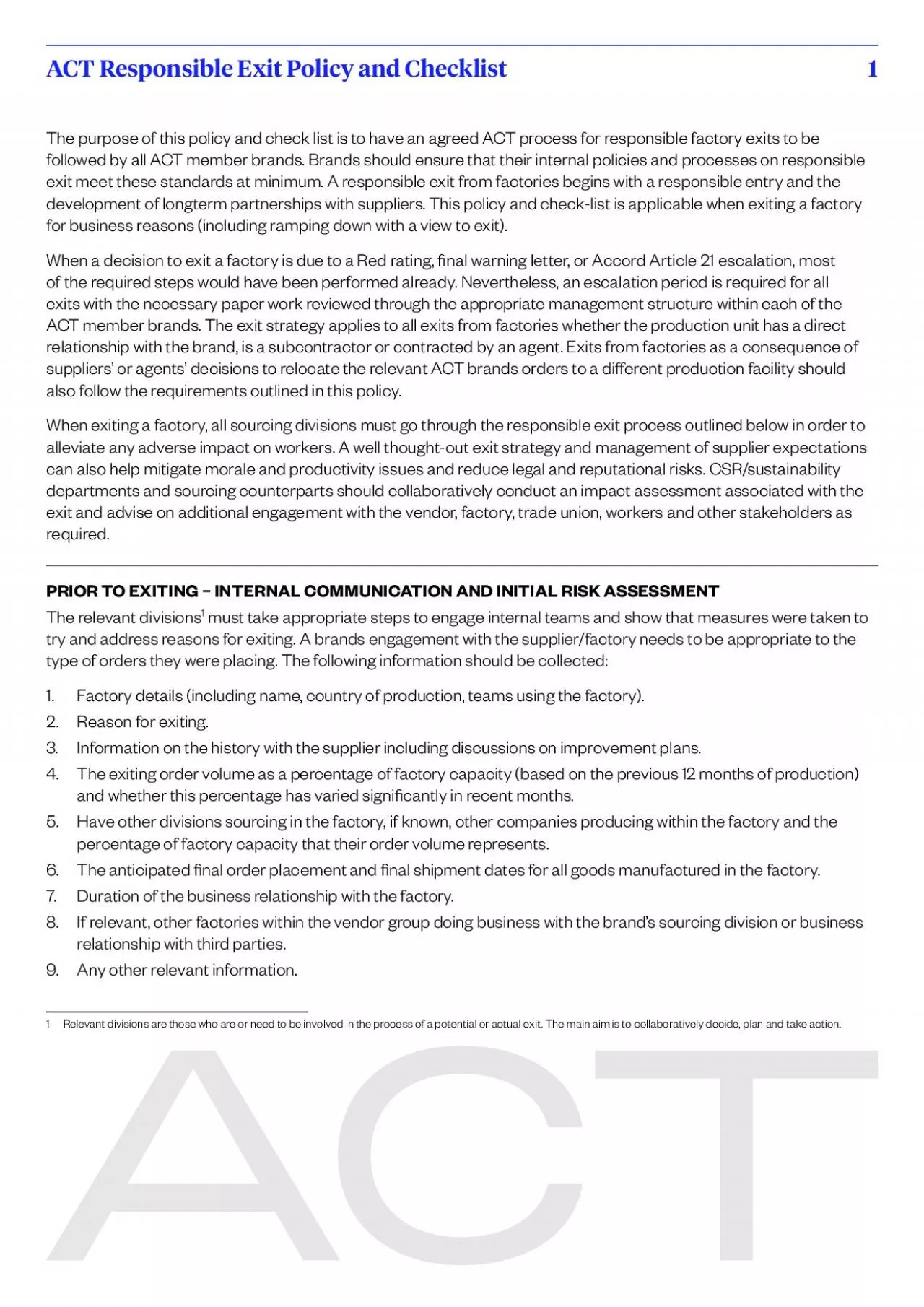

The purpose of this policy and check list is to have an agreed ACT process for responsible factory exits to be followed by all ACT member brands Brands should ensure that their internal policies and ID: 953826
Download Pdf The PPT/PDF document "ACT Responsible Exit Policy and Checklis..." is the property of its rightful owner. Permission is granted to download and print the materials on this web site for personal, non-commercial use only, and to display it on your personal computer provided you do not modify the materials and that you retain all copyright notices contained in the materials. By downloading content from our website, you accept the terms of this agreement.
ACT Responsible Exit Policy and Checklist The purpose of this policy and check list is to have an agreed ACT process for responsible factory exits to be followed by all ACT member brands. Brands should ensure that their internal policies and processes on responsible Relevant divisions are those who are or need to be involved in the process of a potential or actual exit. The main aim is to collaboratively decide, plan and take action. ACT Responsible Exit Policy and Checklist EXITING FACTORIES – COMMUNICATION WITH SUPPLIERS AND ONGOING RISK ASSESSMENTIntention to exit factories should be clearly communicated by the brand to their business partner, and where applicable by the supplier to the factory, in a comprehensive manner and in writing and should be accompanied by a clear timeline. The timeline for exiting a factory should be proportional to the percentage volume the brand or sourcing division has within the factory. As the potential risk for negative outcomes for workers is higher when a large percentage of capacity is withdrawn from the factory it is important to allow for more time for the supplier to nd new clients or, if absolutely necessary, reduce the number of workers in the facility in an appropriate manner. The proposed timeline and volume should be included in the information collected prior to exiting.Throughout the process relevant teams should also:Inform the factory in writing that the relevant divisions will discontinue the business relationship.2.Inform the factory in writing on the relevant divisions’ production order forecast demonstrating intent to reduce business over a speci c timeframe.Inform the factory in writing that where absolutely unavoidable terminations of worker employment have to be done in accordance with local law and the Fair Labor Association’s Retrenchment Guidance as follows.Brands should further engage their supplie
r regarding the impact of the withdrawal on workers. Where possible the brand should engage in conversations on possible negative impacts with the trade unions in the factories. In a rst instance the brand/sourcing division should asses if their exit timeline allowed the factory to “use best e orts to maintain factory capacity”. If capacity cannot be maintained the brand should engage the supplier speci cally on the following:The employer should provide, at the earliest possible opportunity, written notice to the workers of the possibility of employment termination and the reasons therefore.2.The employer should consult with worker(s) and their representatives before a nal decision to dismiss is taken.The employer should ensure that all possible alternatives to employment termination are explored and that workers who are to be dismissed are treated fairly.The employer should ensure that worker(s) whose employment will be terminated are selected objectively.The employer should allow worker(s) whose employment will be terminated time o during the notice period to apply for other jobs.The employer should also ensure that all wages, severance pay and other bene ts are paid according to law.Acknowledgment by supplier that workers were paid (show payment documentation).IMMEDIATELY AFTER EXITING - ASSESSING ADVERSE IMPACT ON WORKERSWhere negative impacts to workers as a consequence of a brand exit are brought to the attention of the brand or IndustriALL, the relevant brand and IndustriALL will engage in a process of mediation and where applicable agree on remediation. This may include, amongst other options, the brand using its remaining leverage to work with the supplier or corporate group in order to ensure that all bene ts and severance payments due and owing are made.In circumstances where brands or IndustriALL have been made aware of these iss
ues prior to the nal payment being made, a solution should be found, where possible, before the nal payment is made. If nal payment has already been made, IndustriALL and brand will work with all relevant stakeholders to nd an appropriate resolution. ACT Responsible Exit Policy and Checklist RESPONSIBLE EXIT CHECKLIST Prior to Exiting – Internal Communications and Initial Risk AssessmentAll relevant information as outlined in the responsible exit policy was shared with the sustainability/ CSR team responsible.A joint assessment of the impact associated with the exit was performed with all relevant teams based on the information provided by the sourcing division.Exiting the Factory – Communication with Suppliers and Ongoing Risk AssessmentA timeline appropriate for the exiting percentage of factory capacity was determined and shared with the supplier in writing.The timeline allowed the suppliers to maintain capacity of the factory after exit.All relevant paperwork has been received by the supplier.Where it is apparent that capacity cannot be lled, the brand has engaged with the supplier to ensure that any terminations are done according to the law and the principles outlined in the responsible exit policy.Where possible the brand engaged with trade union(s) in the factory to assess the possible negative impact on workers of the exit.Immediately After Exiting – Assessing Adverse Impact on WorkersIn the event that suppliers could not maintain capacity in the factory, all reasonable measures were taken to ensure that all wages and legally entitled severance payments were made.Where negative impacts to workers as a consequence of a brand exit were brought to the attention of the brand, they engaged with IndustriALL in a process of mediation and where applicable agreed on remediation. Greifswalder Straße 226, 10405 Berlin, Germanyactonlivingwages.c